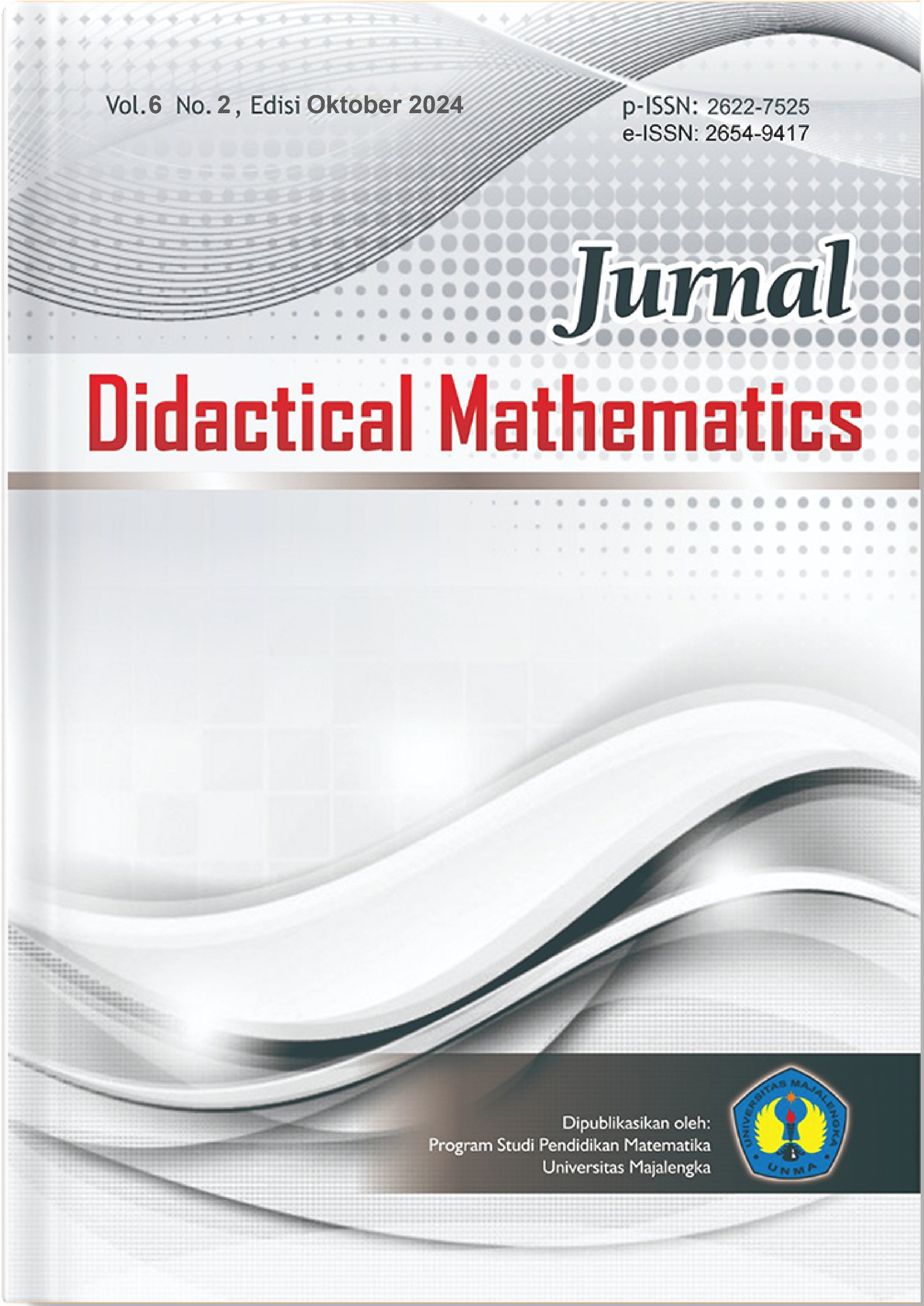Mathematical Literacy and Curiosity Through Creative Problem Solving Learning Using the PMRI Approach Assisted by Photomath
DOI:
https://doi.org/10.31949/dm.v6i2.10822Abstrak
This study aims to show (1) the quality of Creative Problem Solving learning with PMRI approach assisted by Photomath to improve students' mathematical literacy; (2) test the effect of curiosity on students' mathematical literacy through Creative Problem Solving learning with PMRI approach assisted by Photomath. This research is a type of quantitative research using Quasi Experimental on Pretest-Posttest Control Group Design. The population in this study were VIII grade students of SMPN 02 Kaliwedi, Cirebon Regency. Data analysis on learning quality includes the preparation stage, implementation stage and learning evaluation stage. Quantitative data analysis at the learning evaluation stage includes prerequisite tests consisting of normality test, homogeneity test, mean similarity test, while hypothesis testing consists of one sample average test referring to BTA; classical completeness proportion test; 2 mean difference test; 2 proportion difference test; test for average increase in mathematical literacy; and simple linear regression test. The results proved that (a) learning with CPS model with PMRI approach assisted by Photomath was qualified in improving mathematical literacy; (b) curiosity influenced 73.2% of students' mathematical literacy.
Kata Kunci:
Mathematical Literacy; , Curiosity; , Creative Problem Solving; , RME; , PhotomathUnduhan
Referensi
Adjei, S. B. (2015). Assessing Women Empowerment in Africa: A Critical Review of the Challenges of the Gender Empowerment Measure of the UNDP. Psychology and Developing Societies, 27(1), 58–80. https://doi.org/10.1177/0971333614564740
Arikunto, S. (2010). Implementasi Model Pembelajaran Think Pair Share (Tps) Dan Realistic Mathematics Education (Rme) Dalam Upaya Peningkatan Hasil Belajar Peserta Didik Semester Genap Kelas Vii a Smp Muhammadiyah 08 Semarang Tahun Pelajaran 2009-2010 Pada Materi Pokok Himpun. Jurnal Ilmu Pendidikan, 7(2), 809–820.
Danielson, C. (2016). Charlotte Danielson on Rethinking Teacher Evaluation - Education Week. Education Week, 18–21. http://www.edweek.org/ew/articles/2016/04/20/charlotte-danielson-on-rethinking-teacher-evaluation.html
Icam Sutisna. (2020). Statistika Penelitian. Universitas Negeri Gorontalo, 1–15. https://d1wqtxts1xzle7.cloudfront.net/62615506/TEKNIK_ANALISIS_DATA_PENELITIAN_KUANTITATIF20200331-52854-1ovrwlw-libre.pdf?1585939192=&response-content-disposition=inline%3B+filename%3DTeknik_Analisis_Data_Penelitian_Kuantita.pdf&Expires=1697869543&Signat
Ismail, A., Wardono, W., & Agoestanto, A. (2024). Mathematical Literacy In Terms of Learning Independence of Junior High School Students. AlphaMath : Journal of Mathematics Education, 10(1), 110. https://doi.org/10.30595/alphamath.v10i1.21642
Jain, P., & Rogers, M. (2019). Numeracy as critical thinking. Adults Learning Mathematics International Journal, 14(1), 23–33.
Kuswidyanarko, A., Wardono, & Isnarto. (2017). The Analysis of Mathematical Literacy on Realistic Problem-Based Learning with E-Edmodo Based on Student’s Self Efficacy. Journal of Primary Education, 6(2), 103–113. http://journal.unnes.ac.id/sju/index.php/jpe
Lange, J. d. (1987). Boekbespreking “Mathematics, insight and meaning.” 84–89.
Lezhnina, O., & Kismihók, G. (2022). Combining statistical and machine learning methods to explore German students’ attitudes towards ICT in PISA. International Journal of Research and Method in Education, 45(2), 180–199. https://doi.org/10.1080/1743727X.2021.1963226
Madyaratri, D. Y., Wardono, & Prasetyo, A. P. B. (2019). Kemampuan literasi matematika siswa pada pembelajaran problem based learning dengan tinjauan gaya belajar. Prisma, Prosicing Seminar Nasional Matematika, 2, 648–658. https://journal.unnes.ac.id/sju/index.php/prisma/article/view/29213
Masjaya, & Wardono. (2018). Pentingnya Kemampuan Literasi Matematika untuk Menumbuhkan Kemampuan Koneksi Matematika dalam Meningatkan SDM. PRISMA, Prosiding Seminar Nasional Matematika, 1, 568–574.
Rahayu, R., Kartono, K., Dwijanto, D., & Agoestanto, A. (2022). The Effectiveness of Accelerated Problem Based Learning With Dynamic Assessment in Achieving Problem-Solving Skills. ISET: International Conference on Science, Education and Technology, 178–185.
Sibuea, M. F. L., Sembiring, M. A., Almeina, I., & Agus, R. T. A. (2022). Pemanfaatan Aplikasi Photomath Sebagai Media Belajar Matematika. Jurnal Pemberdayaan Sosial Dan Teknologi Masyarakat, 2(1), 109. https://doi.org/10.54314/jpstm.v2i1.962
Sugiyono, S. (2021). The evaluation of facilities and infrastructure standards achievement of vocational high school in the Special Region of Yogyakarta. Jurnal Penelitian Dan Evaluasi Pendidikan, 25(2), 207–217. https://doi.org/10.21831/pep.v25i2.46002
Vintere, A., Safiulina, E., & Panova, O. (2024). Ai-Based Mathematics Learning Platforms in Undergraduate Engineering Studies: Analyses of User Experiences. Engineering for Rural Development, 23, 1042–1047. https://doi.org/10.22616/ERDev.2024.23.TF216
wardhani, sri dan rumiati. (2011). Instrumen Penilaian Hasil Belajar Matematika SMP : Belajar dari PISA dan TIMSS. Yogyakarta: Pusat Pengembangan Dan Pemberdayaan Pendidik Dan Tenaga Kependidikan (PPPPTK) Matematika, 55.
Wardono. (2015). Peningkatan Literasi Matematika Mahasiswa Melalui Pembelajaran Inovatif Realistik E-Learning Edmodo Bermuatan Karakter Cerdas Kreatif Mandiri 1. 6(1), 93–100.
Wicaksana, Y., Ridlo, S., Padma Boulevard Selatan Blok, J. F., & Padma, G. (2017). Unnes Journal of Mathematics Education Research Analisis Kemampuan Literasi Matematika dan Karakter Rasa Ingin Tahu Siswa pada Pembelajaran Berbasis Proyek Berbantuan Schoology. Ujmer, 6(2), 167–174. http://journal.unnes.ac.id/sju/index.php/ujmer
Wijayanto, Z., & Retnaningsih, R. (2019). Considering Students’ Prior Knowledge in Culture-based Contextual Learning Media Application: How Effective It is to Support Students’ Mathematics Learning Outcome. Indonesian Journal of Mathematics Education, 2(1), 14. https://doi.org/10.31002/ijome.v2i1.1207
Yaniawati, P., Fisher, D., Permadi, Y. D., & Yatim, S. A. M. (2023). Development of Mobile-Based Digital Learning Materials in Blended Learning Oriented to Students‟ Mathematical Literacy. International Journal of Information and Education Technology, 13(9), 1338–1347. https://doi.org/10.18178/ijiet.2023.13.9.1936
Yuberta, K. R., Nari, N., & Gustia, E. (2020). Kemampuan Literasi Matematis Siswa Dengan Menerapkan Model Pembelajaran Creative Problem Solving (Cps). Jurnal Saintika Unpam : Jurnal Sains Dan Matematika Unpam, 3(1), 68. https://doi.org/10.32493/jsmu.v3i1.6269
Diterbitkan
Cara Mengutip
Terbitan
Bagian
Lisensi
Hak Cipta (c) 2024 Didactical Mathematics

Artikel ini berlisensiCreative Commons Attribution-ShareAlike 4.0 International License.









